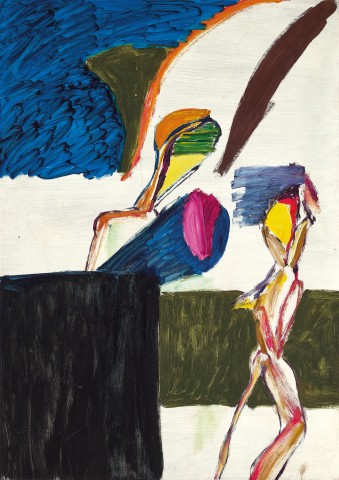UNTITLED (CARLTON CAFÉ KITCHEN), 1969
KEN WHISSON
oil on composition board
86.5 x 61.0 cm
Watters Gallery, Sydney
The Collection of Colin and Elizabeth Laverty, Sydney, acquired from the above in July 1987
Deutscher and Hackett, Sydney, 5 April 2017, lot 66
Laverty collection, Sydney
The Colin and Elizabeth Laverty collection – a selection of Indigenous and non–Indigenous art exhibition, Geelong Gallery, Victoria, 18 February – 15 April 2012
Untitled (Carlton Café Kitchen), 1969 was acquired in 1987 by the celebrated art connoisseurs, Colin and Elizabeth Laverty who frequently selected numerous works by an artist with the aim of charting his or her development. Ken Whisson was a particular favourite, and at one time the Laverty collection would have held around a dozen or more examples of his works spanning his career.
Like many Whisson collectors, they began with his mid-career paintings and then worked back to acquire earlier examples, many of which had remained unsold prior to the mid-1970s when the artist first began to achieve commercial success. The present example is perhaps one of the earliest in their collection. Collecting Whisson’s paintings was largely driven by Elizabeth rather than Colin – who had a particular predilection for abstract art. Elizabeth was the figurative arm of the collecting duo and in view of this it is not surprising that their two sensibilities should find common ground on the surface of Whisson’s work, for few artists tread the line between pure abstraction and figuration with the dexterity of Ken Whisson.
The present example is untitled as Whisson wants his audience to approach the painting with a completely open mind. He encourages us to discover the painting the way he did – to appreciate its painterly forms and colour values as they evolved on the surface. In this instance, as a concession to the viewer he offers a secondary title included in parenthesis, ‘Carlton Café Kitchen’. It is tempting to construct a reading around this, and why not? The interior as he depicts it is stark and minimal, the surface is divided by upper and lower slabs of colour. Within the space which we assume to be a café, two figures gyrate in typical Whisson fashion. One figure appears to be behind the black square, possibly a counter or stove – perhaps cooking, with the dark form above a plume of smoke. The second figure approaches the counter, possibly as a customer or fellow worker in the café’s kitchen. The real contrast and the substance of the work is the opposing treatments between the organic flesh forms of the humans and the rigid architecture of the workplace.
In the late 1960s, Whisson returned from abroad and moved into the bohemian suburb of Carlton. Untitled (Carlton Café Kitchen) was painted at time when the suburb had rich migrant community – jazz music, discussion about art and politics, and anti-Vietnam war sentiment filled the air. Cafes and speakeasies were the natural places for political discourse, and therefore for a political junkie such a Whisson, it follows that these places would be a natural subject for the artist. Any politics, be they local or international, about art and science were central to Whisson’s life and work and accordingly, he would have been a regular voice at rallies gathering and debates – willing to take on even the most passionate adversary with his fever pitch beliefs.
Whisson’s works from this period are not for the faint hearted; they are rigorous, uncompromising propositions that challenge the viewer to set aside preconceived ideas about what a painting should be and instead, to wrestle them towards the fantastic, uncharted world of what a painting could be.
HENRY MULHOLLAND
